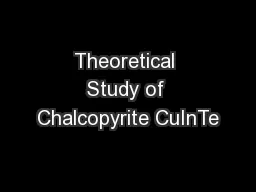

2 as ThermoelectricTE materials 201472 Yoshida lab Shun Miyaue thermoelectric TE 熱電 1 20140702 1Introduction thermoelectric motivation 2 CuInTe ID: 225092
Download Presentation The PPT/PDF document "Theoretical Study of Chalcopyrite CuInTe" is the property of its rightful owner. Permission is granted to download and print the materials on this web site for personal, non-commercial use only, and to display it on your personal computer provided you do not modify the materials and that you retain all copyright notices contained in the materials. By downloading content from our website, you accept the terms of this agreement.
Slide1
Theoretical Study of Chalcopyrite CuInTe2 as Thermoelectric(TE) materials
2014/7/2 Yoshida labShun Miyaue
thermoelectric (TE) : 熱電
1
2014/07/02Slide2
1.Introduction ●thermoelectric
●motivation 2.CuInTe2 ●introduction for CuInTe23.formation energy (calculation)
4.phase diagram 5.sammery & Future Work
Contents
2
2014/07/02Slide3
thermoelectric effect
1.Introduction
Seebeck
effect
(
S:Seebeck
coefficient)
Peltier
effect
(
Π:peltier
coefficient)
K
elvin formula
Thomson
effect
(α:
thomson
coefficient)
relationship
between S &
Π
Thermal energy
electric energy
direct conversion
3
2014/07/02Slide4
motivation
1.Introduction○advantage・No mechanical parts
→
durability for many years.
・
N
o requirement refrigerant fluids and related
chemicals
& reuse waste heat.
→
environmental harmonics
○
problem
・
low efficiency (efficiency = 10%)
・
t
oxic potential・rare
metalhttp://
www.jst.go.jp/pr/info/info951/
http://product.rakuten.co.jp/product/-/199be25f4b205fc73d09795a50582b56/?sc2id=gmc_211752_199be25f4b205fc73d09795a50582b56&scid=s_kwa_pla
4
2014/07/02Slide5
dimensionless figure of merit
1.Introduction(ZT=1 → Carnot efficiency 10%)
G. Jeffrey Snyder et al., Nature Materials
7
(2008)105-114
σ
:electric conductivity
κ
:thermal conductivity
S:Seebeck
coefficient
5
2014/07/02Slide6
dimensionless figure of merit
1.Introduction(ZT=1 → Carnot efficiency 10%)
approach to large ZT
impurity/vacancy → κL
・・・
small
low
dimension →
S
・・・
large
空孔型欠陥
6
2014/07/02Slide7
calculation methods
2.CuInTe2●electronic structure ・FLAPW (Full-potential Linearized Augmented Plane Wave ) method
・DFT/LDA cutoff energy = 24.0[
Hr] lmax
= 7 (spherical wave)
K-point = 432 in 1
st
B.Z
● formation energy
VASP
・
PAW method
・
DFT/
LDA
k-
point
=126 in 1st B.Z
72014/07/02Slide8
CuInTe2
●structure chalcopyrite structure a= 6.189Å ,c= 12.391Å Eg
=1.02[eV]
2
.CuInTe
2
CuInTe
2
(chalcopyrite)
1
2 3 4 5 6
Ⅳ Si The diamond structure
Ⅱ
Ⅵ
ZnTe
The
zincblende
structure
Ⅰ Ⅲ
Ⅵ2
CuInTe2 The chalcopyrite structure
Cu
In
T
e
82014/07/02Slide9
CuInTe
22.CuInTe2
・
previous work[1]
[1]
Ruiheng
Liu,Lili
Xi,Huili
Liu,Xun
Shi,Wenqing
Zhang and
Lidong
Chen
Chem.Commun.,2012,48,3818-
3820
ZT=1.18(850K)
P-type semiconductor
9
2014/07/02Slide10
CuInTe2
2.CuInTe2
・Chalcopyrite
CuInTe
2
→ [2V
cu
+
In
cu
]
→
Cu1-x□2x/3In
x/3Te2
Cu → Cu+ + e
-
Vcu
(Cu vacancy) - accepter
□=Vcu=Cu-vacancy
Cu
In
T
e
Cu
In
Te
Cu-vacancy
In
Cu102014/07/02Slide11
Electronic Structure of CuInTe2
2.CuInTe2
a
nti-bonding state
b
onding state
non-bonding state
11
2014/07/02Slide12
Formation energy
3.calculation
crystal structure including impurity/vacancy ← formation energyformation energy is defined by the follow eq.
12
2014/07/02Slide13
Formation energy
3.calculation
formation energy is defined by the follow eq.
reservoir(
熱浴
)
supercell
Te
Te
Cu
In
13
2014/07/02Slide14
formation energy (形成エネルギー
)3.calculationIt is easy to create Cu-vacancy.
I calculated the formation energy of Cu-Vacancy (q=0).
μ
14
2014/07/02Slide15
phase separation
3.calculation●mixing energy is defined by the follow eq.
phase separating -
spinodal
&
binodal
line
●
entropy
&
free energy
spinodal
line
---
locus
of
inflection
point(∂
2
F/∂x
2 =0) of F(x)
binodal
line ---
locus of tangent point of common tangent
軌跡 変曲点
接点 共通接線
15
2014/07/02Slide16
phase separation
3.phase diagrame.g.Cu(In1-xGax
)S
第一原理計算によるカルコパイライト ベース太陽電池材料の
デザイン
吉田研 谷義政
2012 master thesis
16
2014/07/02Slide17
Summary & Future work
4.summary ・From formation energy, I found that it is easy to create Cu-vacancy.From spinodal &
binodal-line, I’ll try to indicate that the possibility
of phase-separating.
we can control the phase
-
separating in thermal
non
-equilibrium state.Thus, We can expect the large
ZT.
17
2014/07/02Slide18
Summary & Future work
・ I’ll perform supercell method of CuInTe2 including vacancy defects and estimate thermoelectric property. → Band Theory + Boltzmann Equation (VASP /Quantum Espresso +
BoltzWann) → Thermal properties for Chalcopyrite compounds.
my goal,
I’ll design new materials like
chalcopyrite
structure.
5.future work
18
2014/07/02Slide19
formation energy (形成エネルギー
)3.calculation
19
2014/07/02Slide20
formation energy (形成エネルギー
)3.calculationIt is easy to create Cu-vacancy.
I calculated the formation energy of Cu-Vacancy (q=0).
20
2014/07/02Slide21
thermoelectric effect
1.Introductionheat
TE use as generator or
refrigerator
electricity
direct conversion
21
2014/07/02Slide22
motivation
1.Introduction○problem・
low efficiency (efficiency = 10%)・toxic potential・rare metal
our goal
:
conversion efficiency ~30
%
G. Jeffrey Snyder et al., Nature Materials
7
(2008)105-
114
22
2014/07/02Slide23
Electronic Structure of CuInTe2
3.calculation
Cu-3d,In-5p,Te-5p
p-d hybridization
S orbitals
band
DOS
23
2014/07/02Slide24
calculation
●previous work[1] compearison 2.CuInTe2
・
calculation Smax
・
p
revious work
Sxx = 498.2(
μV/K) (450K) Smax
=414.3(
μV
/K)(500K)
Szz
= 487.0(
μV
/K)
(450K)
242014/07/02Slide25
chalcopyrite structure
2.CuInTe2・CIS (CuInSe2/CuInS2
) use as solar cell. CIGS (Ga doping)
phase separating
→
low dimension
第一原理計算によるカルコパイライト ベース太陽電池材料の
デザイン
吉田研 谷義政
2012 master paper
Cu
1-x
□
x
InTe
2
?
25
2014/07/02Slide26
thermoelectric effect
1.Introduction1 Seebeck effect
(
S:Seebeck
coefficient)
26
2014/07/02Slide27
thermoelectric effect
1.Introduction1 Seebeck effect
(
S:Seebeck
coefficient)
n
p
metal
Heat input
e e
I
I
∇T
27
2014/07/02Slide28
thermoelectric effect
1.Introduction
1
Seebeck effect
(
S:Seebeck
coefficient)
2
Peltier
effect
(
Π:peltier
coefficient)
28
2014/07/02Slide29
thermoelectric effect
1.Introductionn
p
metal
e e
I
input
absorption of heat
evolution of heat
1
Seebeck effect
(
S:Seebeck
coefficient)
2
Peltier
effect
(
Π:peltier
coefficient)
29
2014/07/02Slide30
thermoelectric effect
1.Introduction1 Seebeck effect
(
S:Seebeck
coefficient)
2
Peltier
effect
(
Π:peltier
coefficient)
3
Thomson
effect
(α:
thomson
coefficient)
30
2014/07/02Slide31
thermoelectric effect
1.Introduction1 Seebeck effect
(
S:Seebeck
coefficient)
2
Peltier
effect
(
Π:peltier
coefficient)
3
Thomson
effect
(α:
thomson
coefficient)
Heat input
e e
E
E
I
input
evolution of heat
absorption of heat
31
2014/07/02Slide32
previous work[1]
CuInTe2 has good thermoelectrical properties
higher than any other un-doping diamond
zenc
-blende
structual
compound
2
.CuInTe
2
annealing
time
s(μVK
-1
)
σ
(
Ω
-1
m
-1
)
κ(Wm-1K-1
)p(1018 cm-3)
1hour384
35025.4
1.873days273
8242
5.95.757days
25414431
6.010.6
ZT=1.18(850K)at 300K[1]Ruiheng Liu,Lili Xi,Huili Liu,Xun Shi,Wenqing Zhang and Lidong Chen Chem.Commun.,2012,48,3818-3820
322014/07/02